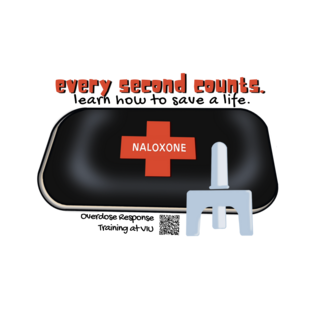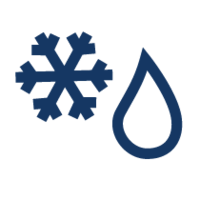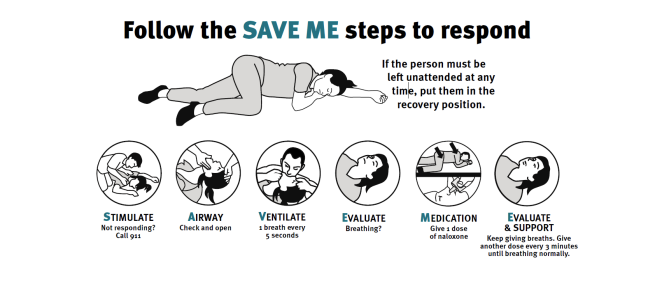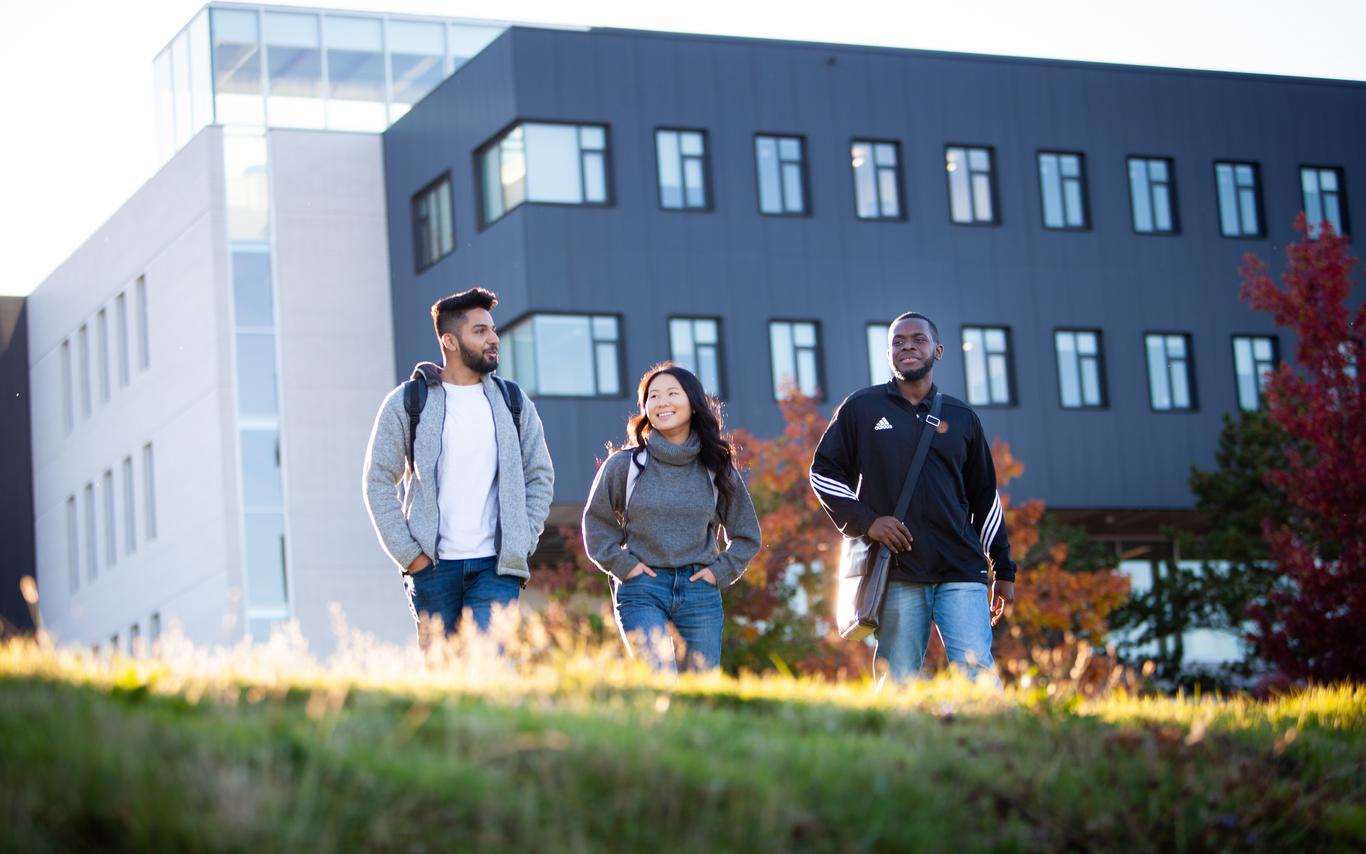Drug Poisoning Alert - Cowichan and Nanaimo Area
Drug Poisoning Alert for Cowichan and Nanaimo. We are sending this alert because there are higher rates of drug poisonings in this community. For more information go to Toward The Heart, Alerts or call 1-888-885-8824 for information on mental health, substance use and harm reduction services. (Msg & data rates may apply)
Congratulations!
Congratulations to Jenny Katsirdakis who is the winner of the create a sticker contest!

Stickers will be around campus soon.
In 2016, the Province of British Columbia declared a public health emergency in response to a significant increase in drug-related overdoses and deaths. This toxic drug crisis, primarily driven by a highly potent and unregulated supply of illicit drugs, remains a complex and evolving issue. Over the past eight years, more than 15,000 lives have been lost.
Raising awareness of the toxic drug supplies and responding quickly to suspected overdoses are critical actions to saving lives. In response to British Columbia’s toxic drug crisis, Vancouver Island University has implemented an Overdose Prevention and Response Plan. Our commitments include:
- Increasing awareness of the dangers associated with BC's street drug supply, educating on how to recognize and respond to an overdose, and providing access to overdose prevention resources.
- Maintaining naloxone kits on campus.
- Offering overdose response training for staff and students.
No penalty for calling for help during an overdose
Student health and safety is our top priority. If you or someone else is experiencing a suspected overdose, please seek help immediately. Students who call for emergency assistance—whether for themselves or others—will not face disciplinary action for drug or alcohol use at that time. Your decision to act could save a life, and we are here to support you without judgment or penalty.
Overdose awareness
Do you know how to tell when someone is having an overdose? Look for these signs and symptoms (graphics below from the provincial government's Help Starts Here website):

Not moving, unresponsive
The person isn’t moving and can’t be woken up.

Slow or no breathing
The person is breathing very slowly or not breathing at all.

Choking sounds
The person is making unusual sounds, like choking, gurgling, gasping of heavy snoring sounds.

Tiny pupils
The person’s pupils look tiny.

Blue or grey lips
The person’s fingernails or lips are turning blue, grey or purple.

Cold and clammy
The person’s skin feels cold and clammy to the touch.
What to do if someone is having an overdose
If someone is having an overdose or showing any signs of over-intoxication, call 911 right away. If you are on campus, you can then contact Campus Security (available 24-7) at 250.740.6512.
Your positive action could save a life. The Good Samaritan Act offers legal protections to anyone who seeks emergency help during an overdose. This includes the person experiencing the overdose, the person who calls for help, anyone who stays at the scene, and even those who leave before first responders arrive. These protections cover simple drug possession charges, so you can call 911 without fear of legal consequences. Don’t hesitate—making the call could save someone’s life.
After calling 9‑1‑1, follow these SAVE-ME steps:
- Stimulate: Try to wake the person. Call their name and squeeze their fingertips or the muscle between their neck and shoulder. If you can’t wake the person, or if you aren’t sure, call 911 right away.
- Airway check: Check if they are breathing normally and check for a pulse (heartbeat). Make sure the airway is clear and remove anything in their mouth. Tilt their head back and open their mouth.
- Ventilate: Help the person breathe by pinching their nose closed and breathing into their mouth once every five seconds. You can use a breathing mask if you have one.
- Evaluate: Are they breathing normally (1 breath every 5 seconds)? If not, get ready to use naloxone.
- Medication: Prepare a 1 mL (one millilitre) dose of naloxone. Your kit may include a nasal spray or an injectable liquid. Follow the steps to administer it.
- Evaluate again: If they are still not breathing normally (1 breath every 5 seconds), give another dose. Keep in mind that naloxone only works for a while. If the drugs are still in the person’s system when the naloxone wears off, they may go back into overdose and need another dose of naloxone.
Graphic courtesy of Toward the Heart:

What is naloxone?
Naloxone is a lifesaving treatment that can temporarily reverse the effects of an opioid overdose. However, its effects are short-lived, so it is crucial to call 911 and then Campus Security immediately after administering it, as further emergency medical care is necessary. Naloxone is safe to use and poses no risk, even if given to someone who is not experiencing an overdose.
VIU naloxone and automated external defibrillator (AED) stations
VIU has nine automatic external Defibrillator (AED) stations and 24 naloxone cabinets across the Nanaimo campus. The naloxone wall cabinets contain nasal spray naloxone, designed for easy use by untrained individuals. This user-friendly spray allows anyone to administer naloxone under the guidance of a 911 operator while waiting for emergency responders to arrive.
Naloxone kits and harm reduction
- All VIU security guards are trained in administering naloxone as part of their first aid training and will call 911 immediately. They carry naloxone at all times.
- In VIU Residences, the Community Leaders, which are on every floor of every building, are trained in administering naloxone. Each of them carries a naloxone kit on their person. There is also a kit at the front desk and front desk staff are also trained. In the event of an overdose, all staff and Community Leaders are taught the recovery position and to call security and then 911.
- There are also naloxone training sessions that are open to all students who live in residence.
- If you use or intend to use unregulated drugs, go slowly, pace yourself, and use around other people. Remember that no unregulated drug is safe and prescription medications should also be treated with caution.
Would you like to host a Naloxone Training Workshop for your department or class?
This interactive session is designed to educate and train participants on how to recognize and respond to an overdose. The workshop includes hands-on Naloxone administration training and provides information about VIU’s Overdose Prevention Program, including campus resources and supports.
Workshops are 30–60 minutes in length, depending on group size and discussion.
To schedule a session, please complete the online booking form below:
Ways to stay safe
- Sign up for Toxic Drug Alerts in your region by texting the word JOIN to 253787.
- Download the Lifeguard Connect App (Apple App Store or Google Play Store). This app connects you with emergency responders if you or someone you know becomes unresponsive.
- Carry naloxone and take a free online naloxone training course (see upcoming training sessions for in-person options)
- Pick up free Intramuscular Naloxone kits from VIU Health and Wellness Centre (Nanaimo campus) by request to front desk.
- Pick up free Take Home Naloxone Kits and harm reduction supplies by visiting the Toward the Heart site finder.
- Get your drugs checked for toxic substances.
- Fentanyl test strips are available for free and anonymously at the VIU Health and Wellness Centre on the resource table in the waiting area
- You can drop off samples in-person at the Canadian Mental Health Association office on Albert Street, or there are mail-in options. Learn more about Nanaimo’s Overdose Prevention Site.
- VIU Community Naloxone Kit Exchange Program
- Exchange your expired Intramuscular Naloxone Kit for a new one at the VIU Health and Wellness Centre (Nanaimo campus) by request at the front desk.
Upcoming education sessions and events
Open to All (students and employees)
Naloxone Training Workshop
Facilitated by Vancouver Coastal Health
Thursday November 27, 2025 12 to 2 pm
VIU tiwšɛmawtxʷ campus | Bldg 148, Room 149
Limited seats!
Harm Reduction Education Panel
Tuesday December 2, 2025 | 2 to 5 pm
Malaspina Theatre
More details to come!
Open to students
VIUSU Naloxone and Harm Reduction Training
Facilitated by AVI Nanaimo
Wednesday Nov 19, 2025 | 3 to 4:30 pm
VIUSU Building | Bldg 193, Room 217
Limited seats!
Resources and workshops
- Opioid treatment access line: 1-833-804-8111
- BC Alcohol & Drug Information and Referral Service: 1-800-663-1441
- BC Pharmacists Naloxone Education
- HealthLinkBC or call 8-1-1
- Suicide Crisis Helpline or call 9-8-8
- KUU-US Crisis Line Society or call 1-800-599-8717
- First Nations Health Authority (harm reduction resources)
- Crisis Centre of BC or call 310-6789 (mental health and crisis response)
- Here2Talk (free mental health support for BC university students)
- HereToHelp has activities to help you think about your own substance use
- Toward the Heart (information about opioids, naloxone and harm reduction)
- Free Naloxone Training
- Help Starts Here BC (BC health, mental health and wellness services)
- Foundry BC (health and wellness services for young people ages 12-24)
- Respond to Overdose (information on overdose prevention and response)
- Building Better Mental Health and Addiction Care (information and resources on mental health and addictions)
- Lifeguard App
- VIU Harm Reduction Alliance (student-made & run website)
- Tailgate Toolkit
- Holding Hope Support groups (Moms Stop the Harm)
- Healing Hearts (Bereavement) Support groups (Moms Stop the Harm)
- Get Your Drugs Tested (Vancouver, mail in option)
- Call Island Health's Service Link at 1-888-855-8824
- Vancouver Island Crisis Line: 1-888-494-3888 (or text: 250-800-3806)
- CMHA - Albert Street Overdose Prevention Site (downtown Nanaimo)
- Substance Drug Checking (Victoria, mail in option)
- Youth Short Term Assessment and Response (YSTAR, Island Health)
- Nanaimo Mental Health and Substance Use Services (Island Health)
- Island Health Overdose Prevention and Supervised Consumption Locations
- VIU Safety App
- VIU Harm Reduction Alliance (student-made & run website)
- Call Island Health's Service Link at 1-888-855-8824
- Vancouver Island Crisis Line: 1-888-494-3888 (or text: 250-800-3806)
- Substance Drug Checking (Victoria, mail in option)
- Youth Short Term Assessment and Response (YSTAR, Island Health)
- Cowichan Valley Drug Checking & Overdose Prevention Site
- 5878 York Road
- 250-597-7779
- Rapid Access Clinic Duncan Mental Health and Substance Use
- 3088 Gibbons Road
- 250-709-3040
- drop-in only Mon-Fri, 10am-2pm
- Island Health Overdose Prevention and Supervised Consumption Locations
- VIU Safety App
- VIU Harm Reduction Alliance (student-made & run website)
- Get Your Drugs Tested (Vancouver, mail in option)
- quathet Community Action Team iOAT clinic | qCAT
- VCH Overdose Outreach team Overdose Outreach Teams | Vancouver Coastal Health
- Powell Reduction Harm Reduction Services
- Powell River Drug Checking & Overdose Prevention Site located at 4410 Joyce Ave
- VCH Supervised Consumption and Overdose Prevention Sites
- ?aǰimɛt harm reduction circle:
- direct line 604-900-9411
- cell 604-413-3344
- 5160 Highway 101, Tla'amin Nation
- VIU Safety App
- VIU Harm Reduction Alliance (student-made & run website)
